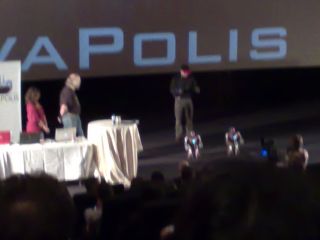“Please Neal,” Pleads Gosling
Bob Lee’s session on Guice got mixed reviews. Having already seen his introduction to Guice, I had an pretty good idea of what Guice is, so I enjoyed hearing about his 50 or so best practices and previews of things to come. However, I spoke with another visitor afterwards who was less impressed; he had expected more of an introductory session.
Right now I’m in a GWT session where one of the speakers has been delayed and time is being killed by someone demoing GWT applications somewhere on the Internet, followed by another substitute who starts his presentation with the announcement “Let’s see how fast we can go through this stack of slides.” and welcomes every slide with a half-surprised “Okay…” — has he even seen these slides before?
To start the day off, there was a triple keynote: Stephan Janssen, building up via Bruce Eckel to James Gosling himself. Something that caught my attention on one of his slides: Java would enable you to “Learn Once, Work Anywhere”. Is that really true? Even in the Java EE world I’m in, developers are getting more and more specialized, making a switch non-trivial — let alone the gap that exists between business application and real-time development. Yes, the language may be the same, but different libraries, frameworks, and even the entire context within which you’re working may well require you to virtually start afresh, if you’re thinking about switching.
There was of course some obligatory promoting of NetBeans 6 and Java FX; a short and not very impressive demo with Sunspots and robots (read the book, seen the movie — again!); and a plea to Neal Gafter to get closures into Java 7. Which is kind of weird if you think about it: the “father of Java” asking a Googler to please implement the feature the he himself was unable to include in Java in the first place.

Simon Ritter doing a robot demo
Near the end, I saw a JasperSoft employee losing about 5 litres of sweat: his guest appearance in Gosling’s session went sour when the beamer, switched over to his laptop, remained black for an uncomfortable number of minutes. The gum he was chewing did not help his demo either, by the way.
The GWT session did not end well. Both guest presenters battling for attention, both ignoring any comments one makes about the other’s slides; as well as the text on half of the slides being garbled and unreadable… Fortunately GWT looks slick enough (both code and end result) but definitely needs better promotors.
2007-12-12. 4 responses.
Oh,
That’s funny.Thanks for sharing the happenings there.
Thanks
Prashant Jalasutram
http://prashantjalasutram.blogspot.com/
“Please Neal,†Pleads Gosling…
[…]Gosling asks Gafter to get closures into Java….[…]…
“Learn once, work everywhere”
From my personal experience, that is quite true. I started programming in Java in 1997, and since then I have built web applications, database applications, mobile applications for Palm and Pocket PC, an application server for CTI applications, CORBA-based distributed applications, network management applications, server-side business components for application servers, fat-client business applications, an IDE, a Rich Client Platform, a modeling tool among other kinds of software. All that across different operating systems and using similar products by different vendors.
Of course I had to learn something new for each kind of “application style”, but the programming language and core class library were always there for me. That is a *huge* thing. Before Java, it was really hard to move from one domain to another, or even move from vendor to vendor. Sun has my eternal gratitude for bringing some sanity to the software development industry.
Hi,
Can any one help me on NETUI DataGrid control. I wish to save the index when user performs any action on the page and display the same page. For example when a user selects to delete a record, the Data Grid paging is going back to first page where as user have to be in the page where he has deleted the record.
Thank you.